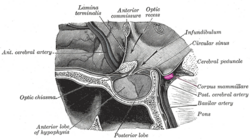| Mammillary body | |
|---|---|
 Sagittal section, "Corpus mamillare" highlighted. Sagittal section, "Corpus mamillare" highlighted. | |
 Coronal section of brain through intermediate mass of third ventricle. (Label "Corpora mamillaria" at bottom.) Coronal section of brain through intermediate mass of third ventricle. (Label "Corpora mamillaria" at bottom.) | |
| Details | |
| Part of | Diencephalon |
| System | Limbic |
| Parts | medial mammillary nucleus lateral mammillary nucleus |
| Identifiers | |
| Latin | corpus mamillare (plural: corpora mamillaria) |
| Acronym(s) | mmb |
| MeSH | D008326 |
| NeuroNames | 412 |
| NeuroLex ID | birnlex_865 |
| TA98 | A14.1.08.402 |
| TA2 | 5674 |
| FMA | 74877 |
| Anatomical terms of neuroanatomy[edit on Wikidata] | |
The mammillary bodies also mamillary bodies, are a pair of small round brainstem nuclei. They are located on the undersurface of the brain that, as part of the diencephalon, form part of the limbic system. They are located at the ends of the anterior arches of the fornix. They consist of two groups of nuclei, the medial mammillary nuclei and the lateral mammillary nuclei.
Neuroanatomists have often categorized the mammillary bodies as part of the posterior part of hypothalamus.
Structure
Connections
They are connected to other parts of the brain (as shown in the schematic, below left), and act as a relay for impulses coming from the amygdalae and hippocampi, via the mamillothalamic tract to the thalamus.
The lateral mammillary nucleus has bidirectional connections with the dorsal tegmental nucleus. The medial mammillary nucleus connects with the ventral tegmental nucleus.
Function
Mammillary bodies, and their projections to the anterior thalamus via the mammillothalamic tract, are important for recollective memory. According to studies of rats with mammillary body lesions, damage to the medial mammillary nucleus lead to spatial memory deficits.
Clinical significance
Damage to the mammillary bodies due to thiamine deficiency is implied in pathogenesis of Wernicke–Korsakoff syndrome. Symptoms include impaired memory, also called anterograde amnesia, suggesting that the mammillary bodies may be important for memory. Lesions of the medial dorsal and anterior nuclei of the thalami and lesions of the mammillary bodies are commonly involved in amnesic syndromes in humans.
Mammillary body atrophy is present in several other conditions, such as colloid cysts in the third ventricle, Alzheimer's disease, schizophrenia, heart failure, and sleep apnea. In spite of this the exact function of the mammillary bodies is still not clear.
See also
References
- Henry Gray (1918). Anatomy of the Human Body.
- Peterson, Diana C.; Reddy, Vamsi; Mayes, Debra A. (2024). "Neuroanatomy, Mammillary Bodies". StatPearls. StatPearls Publishing. Retrieved 9 October 2024.
- "Mammillary Bodies". Springer Reference. Retrieved 2013-06-03.
- Vann SD, Aggleton JP (January 2004). "The mammillary bodies: two memory systems in one?" (PDF). Nature Reviews. Neuroscience. 5 (1): 35–44. doi:10.1038/nrn1299. PMID 14708002. S2CID 15027244..
- M.B. Carpenter and J. Sutin: Human Neuroanatomy (8th edition) 1983
- Peterson, Diana C.; Reddy, Vamsi; Mayes, Debra A. (2024). "Neuroanatomy, Mammillary Bodies". StatPearls. StatPearls Publishing. Retrieved 16 September 2024.
- ^ Vann SD (July 2010). "Re-evaluating the role of the mammillary bodies in memory". Neuropsychologia. 48 (8): 2316–27. CiteSeerX 10.1.1.372.1373. doi:10.1016/j.neuropsychologia.2009.10.019. PMID 19879886. S2CID 2424758.
- Duprez TP, Serieh BA, Raftopoulos C (January 2005). "Absence of memory dysfunction after bilateral mammillary body and mammillothalamic tract electrode implantation: preliminary experience in three patients". AJNR. American Journal of Neuroradiology. 26 (1): 195–7, author reply 197–8. PMC 7975039. PMID 15661728.
External links
- "Anatomy diagram: 13048.000-3". Roche Lexicon - illustrated navigator. Elsevier. Archived from the original on 2012-07-22.
| Anatomy of the diencephalon of the human brain | |||||||||||||||
|---|---|---|---|---|---|---|---|---|---|---|---|---|---|---|---|
| Epithalamus |
| ||||||||||||||
| Thalamus |
| ||||||||||||||
| Hypothalamus |
| ||||||||||||||
| Subthalamus | |||||||||||||||
| Papez circuit pathway | |
|---|---|
| Diencephalon | |
| Telencephalon | |
